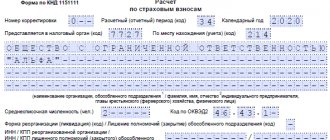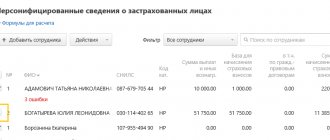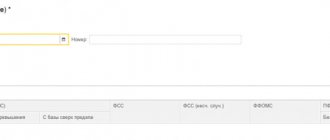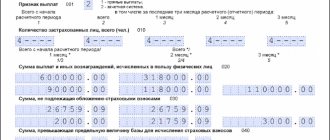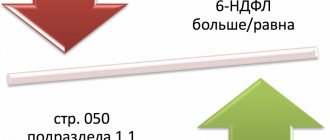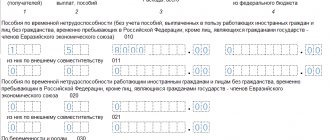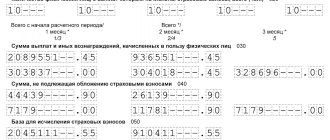Programs for checking the calculation of insurance premiums for 0 rubles. 0 kop.
How to check the calculation of insurance premiums in 2020-2021?
This question worries not only novice accountants, but also experienced professionals. The control ratios for checking calculations have been supplemented several times recently, so for successful completion of the calculation it is important to use up-to-date and preferably free checking programs. The Internet is replete with offers for free verification of insurance premium calculations. Are they all really free? What exactly is offered to policyholders - a full check of the calculation or a stripped-down version that does not allow them to see the details of the errors?
Would you like to receive exclusive information about how a desk audit of insurance premium calculations is carried out? Detailed explanations about this are given by 2nd class adviser to the State Civil Service of the Russian Federation E. S. Grigorenko. You can view them in ConsultantPlus, trial access to which can be obtained for free.
Among the truly absolutely free programs for checking the calculation of insurance premiums are the services of the Federal Tax Service. There are many such useful free services on the official website of this department.
Taxpayers and policyholders hold in high esteem the free service for generating and checking “Taxpayer Legal Entity” reports. This program allows policyholders to:
- fill out the calculation of insurance premiums;
- check it for errors;
- do not worry about the relevance of its form;
- do not be afraid of incorrect electronic format.
Another available and free program for checking insurance premium calculations in 2021 is the Tester program. It can be downloaded in the public domain on the Federal Tax Service website at the following link:
All offered services (both paid and free) for checking insurance calculations are based on more than 300 control ratios, with the help of which shortcomings, inconsistencies and discrepancies in calculation data are identified.
In addition to the programs of the Federal Tax Service, the calculation of insurance premiums can be checked in other ways - we will talk about them further.
Main nuances of submitting a document to the Federal Tax Service
The transfer of the document to the authorized tax authorities must be carried out to the territorial branch of the Federal Tax Service in which the policyholder is registered.
Calculation of premiums falls into the category of quarterly reports, the provision of which is a mandatory requirement for policyholders at the end of each quarter of the year. Thus, the ERSV must be submitted to the Federal Tax Service no later than the 30th day of the month following the reporting quarter of the year.
The document can be submitted either in paper or electronic form. However, depending on the number of employees working under an employment contract, tax authorities have established certain restrictions. If the total number of employees is less than 25 people, the report can be submitted in both paper and electronic format.
When do you need to pay money to check an insurance calculation?
Most companies and individual entrepreneurs prepare calculations for insurance premiums (as well as other tax reporting) electronically. This usually happens using a program used for accounting purposes.
The most well-known programs of this kind are products. The programs allow you to automate and keep tax and accounting records up to date, including the preparation of mandatory (regulated) reporting.
We will tell you how to automate accounting and generate reporting using 1C in these publications:
- “Maintaining separate accounting for VAT in 1C (nuances)”;
- “How to generate a SZV-M report in 1C (nuances)»;
- “The procedure for forming 6-NDFL in the 1C program”.
It provides its users with the opportunity to check the calculation of insurance premiums without any additional fees. However, a commercial product cannot have zero cost. Only those users who have already paid for access to the main accounting program can identify calculation errors for free using the 1C family program.
Other companies providing similar services have a similar approach.
For whom are the reduced rates developed?
Reduced tariffs were introduced for small and medium-sized enterprises. In accordance with Federal Law 102-FZ dated April 1, 2020, SME companies can use a reduced rate of 15% instead of the required 30% when calculating insurance premiums. Read more in the topic: “How to correctly calculate insurance premiums at a reduced rate?”
The possibility of applying a preferential tariff is determined by the amount of wages paid. Only those companies that pay their employees a salary exceeding the federal minimum wage - 12,130 rubles - can apply a reduced rate. If this indicator is not met, then the company must charge contributions at a rate of 30%. Also, only those companies that are included in the small business register can use the benefit.
The preferential tariff applies only to that part of the salary that exceeds the minimum wage. Payments within the minimum wage are taxed at the previous rate. There have been no changes to contributions for injuries, as they are calculated separately from pension, medical and social contributions.
Trap for policyholders: free and paid services
Some websites invite insurance premium payers to use a free service to check insurance premium calculations. To check, you just need to upload a report in xml format into the program offered by the service.
After checking it, the control result is issued. In any form? See the picture below:
It's good if there are no errors in your calculation. You will achieve your goal - make sure that after sending the report to the tax authorities there will be no claims. Everyone is happy: the service was provided, the report was checked, there were no errors.
If at least one control relationship is not met when checking a calculation, you will receive a warning that:
- errors were found in the calculation;
- not all control ratios converged;
- the calculation needs to be revised;
- If the errors are not corrected, the calculation will not pass the desk audit, you will have to submit explanations, pay a fine, and submit an updated calculation.
At this stage, a trap awaits you: the report has been checked, the presence of errors in it has been determined, but you do not know:
- how many control ratios did not converge;
- in which specific lines you made a mistake and how to make corrections.
It’s good if you are subscribers of a publication that offers this free service (for example, the magazines “Accounting for IP”, “Vmenenka”, “Uproshchenka”). Subscribers are offered an advantage when using the service - access to error details. If you are not one of the subscribers, you are not destined to find out:
- in what relationships the calculation does not converge;
- what is the cause of the error.
Moreover, no one will tell you what to do if a particular error is detected. To have access to all this useful information, you need to become a subscriber to the publication. This is a modern free-to-pay service.
Correction of identified errors
Once errors are identified, they must be corrected. Otherwise, the Pension Fund will not accept the reports, and this may result in fines. Therefore, it is recommended that verification be carried out before sending documents to the department.
Among the most common errors are various types of typos and blots. For example, unnecessary punctuation marks, incorrect spelling of full name, inconsistency with SNILS, etc. The critical ones are:
- incorrect details;
- incorrect signature;
- incorrect file format.
In such cases, a resubmission of the report will be required. Errors related to the presence of spaces in SNILS and TIN, extra zeros in these codes, as well as hyphens and spaces when writing surnames, must be corrected. If they are found before reporting is submitted, then it is submitted with the code “output”. If errors are discovered after submission, then the corrected report must be submitted with the code “additional”. Also, supplementary reports are submitted if a discrepancy in SNILS and incorrect full names are identified.
There are errors, the correction of which is not mandatory unless other more significant errors are found in the documents. For example, the Pension Fund of Russia can forgive empty fields for recording full name and tax identification number, the use of the letter “ё”, apostrophes, brackets and Latin letters.
We emphasize that if the check fails, most likely the problem lies in the incorrect file format. You can visually determine whether the file meets existing requirements. In particular, its name should look like this:
Pension Fund_[reg. number]_[PFR TO code]_SZV-M_[file generation date]_[GUID].xml
Results
A program for checking the unified calculation of insurance premiums is available (Tester program). Users of the free service “Legal Taxpayer” have the opportunity to monitor their calculations for errors without any additional payments in this program.
Many electronic accounting publications offer to check your calculations for free. But a detailed description of errors can only be obtained by being a subscriber to such a publication. For other users of the service, if the test result is negative, the program will issue a warning about the presence of errors without detailing them.
Sources: Tax Code of the Russian Federation
You can find more complete information on the topic in ConsultantPlus. Free trial access to the system for 2 days.
Responsibilities of contribution payers
The main responsibilities are:
- payment of dues
- keeping records of taxable objects, calculated amounts for each employee to whom payments were made
- submission to the Federal Tax Service RSV
- submission of supporting documents and information about insured persons to the Federal Tax Service
- ensuring the safety of documents for 6 years
- informing the Federal Tax Service about the granting of powers to a separate division within 1 month
The following categories of payers are distinguished:
- making payments to individuals: organizations, individual entrepreneurs, individuals who are not individual entrepreneurs
- payers who do not make payments: individual entrepreneurs, lawyers, notaries, appraisers and other persons in private practice
The adoption of new laws in the field of insurance premiums will reduce the administrative burden on business by reducing the number of regulatory government agencies, optimizing reporting, reducing the number of inspections and improving their quality.
ANO VO "Institute of Business and Design" N. Prodanova
How to check the correctness of filling out the Calculation
The procedure for filling out the Calculation of Insurance Premiums is given in Appendix No. 2 to the Order of the Federal Tax Service of Russia dated October 10, 2016 No. ММВ-7-11/ [email protected] However, the Procedure does not say how to check the correctness of filling out the form.
In order for the tax inspectorate to control the correctness of filling out the Calculation, Control Ratios were developed. The first Control ratios for the new Calculation form were released back in March 2021 (Letter of the Federal Tax Service dated March 13, 2017 No. BS-4-11 / [email protected] ). In June 2021, the tax department updated its Control Ratios by issuing Letter of the Federal Tax Service dated June 30, 2017 No. BS-4-11/ [email protected] Of course, the payer of insurance premiums can also use them for self-checking.
The control ratios in the report for Calculation of insurance premiums are presented in the form of a table consisting of the following main columns:
- content of the control ratio;
- a link to an article of the Tax Code of the Russian Federation, the norms of which are associated with a possible violation of the law if the control ratio is not met;
- wording of the violation;
- actions that the tax office and the payer must take when such an error is detected.
Let us present examples of intra-document control ratios for insurance premiums:
| Contents of the reference ratio | If the control ratio is not met | ||
| Possible violation of Russian legislation | Formulation of the violation | Actions taken | |
| Gr. 3 tbsp. 061 subsection 1.1 adj. 1 = Σ page 240 (1 month) subsection. 3.2.1 | Art. 431 Tax Code of the Russian Federation | The total amount of calculated insurance premiums for compulsory health insurance for the first month of the last quarter from a base not exceeding the maximum value, in general for the payer the amount of contributions for the same month from a base not exceeding the maximum value for each individual | The payer of insurance premiums, no later than the day following the day of receipt of the Calculation in electronic form (10 days following the day of receipt of the calculation on paper), is sent a corresponding notification |
| Art. 050 rub. 1 = Σ all gr. 1 tbsp. 0 60 other 1.2 adj. 1 rub. 1 | The amount of insurance premiums for compulsory medical insurance payable for the reporting period the amount of contributions for the reporting period for each type of tariff | Check whether the amount of calculated insurance premiums has changed during a desk tax audit of the calculation for the previous reporting period. If, taking into account the results of a desk tax audit, the control ratio is not met, then in accordance with Art. 88 of the Tax Code of the Russian Federation, send the payer a request to provide explanations or make appropriate corrections within 5 working days. If, after consideration of the provided explanations and documents, or in the absence of explanations, a violation of the legislation on taxes and fees is established, an inspection report is drawn up in accordance with Art. 100 Tax Code of the Russian Federation | |
Control ratios (Letter of the Federal Tax Service dated June 30, 2017 No. BS-4-11/ [email protected] ) also provide for inter-documentary reconciliations, i.e., checking the Calculation with form 6-NDFL, as well as with information from the Social Insurance Fund.
So, for example, the control ratios of 6-NDFL and insurance premiums are as follows:
The amount of accrued income of the taxpayer, excluding the amount of accrued income from dividends
How to work with online resources
The report verification algorithm depends on the selected software type. In general, the operating procedure is as follows:
- Prepare the report electronically. For example, use specialized accounting programs or applications from the official website of the Federal Tax Service.
- Check the finished report using internal control. Such actions provide standard settings for accounting programs.
- If the program does not support intra-form control, then you can check the RSV like this:
- download the report in XML format—this is a special reporting format;
- upload the report file to the application for verification;
- or upload reports to the website;
- follow the recommended software actions;
- correct errors identified by the check;
- submit reports to the Federal Tax Service.
When using the new online service for reconciling insurance premium reports, be vigilant. Some sites offer a free test - a one-time reporting reconciliation. Further control of the forms will be paid.
For example, if the site requires you to enter a phone number or card, then most likely money will be debited from your accounts. But reporting control services may not be provided. Fraudsters have come up with a number of tricks. For example, during an online check, the site produces a new error that the accountant has not encountered before. But the service does not provide explanations for the shortcomings, but requires payment. Be carefull!
We talked about the new form of calculation of insurance premiums, submitted to the tax office in 2017, in our consultation and gave an example of filling out insurance reporting. What are the control ratios for insurance premiums?
Calculation and payment of contributions
Employers are required to calculate and pay contributions on a monthly basis no later than the 15th day of the following month after payments are made.
The amount of contributions must be calculated in rubles and kopecks separately for each type of insurance: compulsory insurance, compulsory insurance, compulsory medical insurance.
The billing period is a calendar year, reporting periods: 1st quarter, half-year, 9 months of this calendar year.
In connection with the transfer of the administration of contributions from 2021 to the jurisdiction of the Federal Tax Service, the BCC for the transfer of contributions has changed.
Each type of contribution has its own BCC (20 digits), which is the same for contributions, penalties and fines:
| Contribution | KBK |
| OPS | 1821020211061010160 |
| OSS | 18210202190071010160 |
| Compulsory medical insurance | 18210202101081013160 |
Kontur-Extern – reporting via the Internet to the Pension Fund of Russia
Immediately after creation and verification, the report can be sent to the territorial body of the Foundation and receive a verification protocol. Reports created using this service can be downloaded in .xml format to any medium if, for example, you need to use another email program.
The advantages of electronic reporting systems are obvious: it is fast, convenient, safe and quite cheap compared to maintaining a full-time accountant. In business, you should always prefer a large company, such as ZAO PF SKB Kontur. The most famous product is the Kontur-Extern service - an electronic system for submitting reports to all regulatory authorities, including the Pension Fund.
Desk inspection of SZV-M
7. Checkpsn
For reporting to the Pension Fund up to 2006 inclusive,
obtain the CheckPSN verification program.
To use the CheckPSN program, unpack the file you received using any archiver. As a result of unpacking, you will have several files. One of them is the checkpsn.exe file. Now you can configure the Archa program to its location on your computer. To do this, in the Archa program, in the “Settings” menu item, where in the “for Unified Social Tax and Pension Fund” tab there is the attribute “External Relations” there is the attribute “Location of the Pension Fund verification program. Location of Checkpsn.exe".
CheckPFR
If it turns out to be positive, then the report is considered to be submitted on the same date as the confirmation was sent. If it is negative, then all information must be sent again, after correcting all errors.
To add a new employee, you need to enter his full name, SNILS number and category, that is, explain his status in the organization. Here you enter data on length of service, accruals and calculate contributions to be paid.
Essence of the question
Control ratios for the calculation of insurance premiums for 2021 are a method of mathematical control of the entered data. It helps to check the correctness and correctness by comparing certain groups of indicators. Using this method, tax authorities and payers can find out whether the unified calculation of insurance premiums is filled out correctly. Almost always, methods of mathematical verification are presented in the form of tables, which contain:
- calculation formulas indicating fields, rows, cells and sheets;
- references to the norms of current legislation that are violated in the calculations of contributions;
- commentary on the violation of fiscal legislation;
- actions of a representative of the tax inspectorate when a violation is detected.
The new table of control ratios presents not only methods for checking data within the report, but also control ratios of 6-NDFL and insurance premiums. For example, a new condition applies: an economic entity that has submitted a report in Form 6-NDFL is required to report in the DAM form. If the calculation of contributions was not provided on time, the tax authorities will send a request to provide a report in a unified form.
